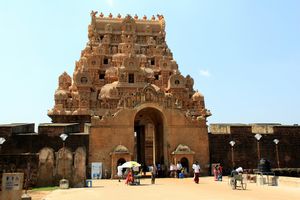Advertisement
Published: August 20th 2012

 Brihadeeswarar 1
Brihadeeswarar 1
the gopuram, main entranceStanding right in front of the Great Temple of the Empire Chola, I could see this is very old; it has the rustic ancient architectural design, high walls on both sides, with the only huge high entrance I know just below the Gopuram. The Gopuram has got nine layers of magnificent carvings of Great Gods of Hindus. This temple is dedicated to Lord Shiva, The Destroyer. This temple is named Brihadeeswarar Temple or is also known as Rajarajeswaram Temple, The Imperial Chola Temple built by Raja Raja Chola I in the 11
th century, 1010 CE. It is situated on the south end of the Kaveri River in Tamil Nadu.
It was the Vijayalaya (850-871 CE) who had defeated the Pallavas, Pandyas and the Muttaraiyas that paved the way for the Cholas to rule this Uraiyur region. The Great Chola held major parts of Sri Lanka and the South India, their presence over the North India that stretches all the way to South East Asia.
Mr. Ganesh from Singapore had a holiday in India, visiting his brother-in-law who resides in Thanjavur, approached me (the only Chinese in this temple) with knowledge to share. He said the Great Chola or the

 Brihadeeswarar 2
Brihadeeswarar 2
entrance into main templeGreat Cholan has his kingdom all the way to Singapore. The Raja Raja Chola’s son(Raja Rajendra I) resided in Singapore refused to come back until his father was taken ill, his father summoned his solders to bring back his son to India. Later his son built another Chola Empire not far from his fathers’ land, a replica of Brihadeeswarar.
From my knowledge, Bay of Bengal is also known as Lake Chola. In Kuala Lumpur, we have a road name after the Cholas, it is Jalan Raja Chulan (Raja Chulan Road). According to Mr. Ganesh, many of Raja Rajendra I descendants are in Singapore and Malaysia with the surname of Chola or Cholan that I have yet to meet them. In his conquests, he has colonized Burma, Andaman and Nicobar Island, Maldives and the Kingdom of Srivijaya, Palembang in Sumatra, Java and the Malay Peninsula. So this is true after all, the Malay Archipelago was once a Hindu colonization. Bali is one good example to reckon with.
[The use of the term "Melayu" and its other spelling variants can be traced back to the beginning of
Common Era. Among its earliest appearance was in

 Brihadeeswarar 3
Brihadeeswarar 3
small vendor beneath the gopuram where the word "Malayadvipa" (literally "insluar mountain continent") was mentioned, referring to the mountainous terrain of
Malay Peninsula. Then, the term "Maleu-Kolon" was used in
Geographia by
Ptolemy which is believed to have originated from the Sanskrit term malayakolam or malaikurram, referring to a geographical part of Malay Peninsula.
In 7th century, the first use of the term for a nation or a kingdom was recorded by I Ching. An inscription on the south wall of the 11th century
Brihadeeswarar Temple also made a reference to Malaiyur, a kingdom that had "a strong mountain for its rampart" in Malay Peninsula that fell to the
Chola invaders during
Rajendra Chola I's campaign.]-Wikipedia, The Melayu Kingdom
In the Brihadeeswarar, there are few shrines built around the main temple. There is a Nandi shrine, 6m in length, 3m in height, weighs 25 tons. It was carved from one single rock. Nandi is the black bull. I was told he is the teacher to Lord Shiva. There are shrines like Lord Ganesha, Lord Subramaniam, Amman and the Karuvur Deva, The Royal Priest. The main shrine is the main attraction; it contained the biggest Lingam in India. The temple tower is 60m
in height, considering the tallest temple in India and maybe the world. It has an eighty one ton Dome on the top of the tower. One wonders how on earth they could lift the dome to the top.
I walked round the temple, I saw many Lingams along the hallway and the paintings on the walls were exquisite. There 250 Lingams all the way, each has its own meaning, referring to their elements of the universe. There are 108 statues in 108 dances of Bharathanatyam Yajna, enacted by classical dance of Tamils. Each statue has different style of postures and hand mudras. A classical story told in these dances. What amazed me were the inscriptions in Tamil inscribed on most walls. This Tamil inscription is said to be the oldest language in the world. I have wondered, does the 21
st century Indians know how to read these ancient Tamil inscriptions? How different compared to the Tamil words in modern time today? How many years have these artisans inscribed on these walls? I was told it has the story of the great achievements of the Raja. This is his pride and joy inscribed for the people to read.
This

 Brihadeeswarar 5
Brihadeeswarar 5
the wall inscriptions in old tamilGreat Living Chola Temple was nominated as the UNESCO World Heritage in 1987. They celebrated grandly in year 2010 to commemorate 1000 years history. Though it has been 1100 years ago, this Brihadeeswarar Temple still stood mighty in its own charming way, the era of the once great kingdom owned by a great Raja with rich history that certainly will have many people come to see and to read about.
Thanks to Mr. Ganesh who has made this story possible for me to do my research further on the story of Raja Rajendra Chola in South East Asia. I was happy to have met someone close to home and became friends from that point onwards. I hope we will meet again, same place? Hopefully YES.
Advertisement
Tot: 0.182s; Tpl: 0.016s; cc: 15; qc: 103; dbt: 0.0964s; 1; m:domysql w:travelblog (10.17.0.13); sld: 1;
; mem: 1.3mb























